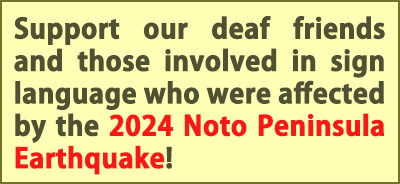from 1 February 2009 Issue of Japanese Deaf News, JFD’s monthly newspaper:
This year marks the 20th Anniversary of the National Sign Language Interpreter Certification System. In that regard, the system has become a 20-year-old “full grown-up”. In May 1989, the Ministry of Health and Welfare (current Ministry of Health, Labour, and Welfare) made an announcement regarding the “Project on the examination and certification of sign language interpreting knowledge and skills”, which was the first official regulation on sign language interpreting in our country. In June of the same year, the government designated the examination conducted by the Information and Culture Center for the Deaf (ICCD) to be the official testing system of the nation, and announced that those who passed the examination would be officially certified by the Minister of Health and Welfare to be a “National Certified Sign Language Interpreter (Shuwa Tsuyakushi)”. As of January 15th 2009, 2015 sign language interpreters throughout Japan have been accredited by this national certification system. Following are comments on this 20-year history of the certification system from the representatives of the related organizations.
The Challenge is to Increase Job Opportunities for Certified Interpreters
Ms. Eiko Ogura
President of Japanese Association of Sign Language Interpreters (JASLI)
Our Association was established 3 years after the first examination was conducted, for the purpose of improving the quality and skills of sign language interpreters, and contributing to the development of the sign language interpreting system in Japan. We made the ‘Code of Ethics for Certified Sign Language Interpreters’ in 1997, and we have worked hard to gain social recognition as a professional group. Currently, the number of nationally certified interpreters is increasing slowly but steadily. Social recognition is also progressing. It has been decided that only sign language interpreters who are nationally certified can interpret for the candidates in the national proportional representation election campaigns of the House of Councilors. More and more local administrations require the national certification as requirement when hiring staff for sign language interpreter projects. Despite this increased social recognition, we are still confronted with a big issue, which is that the certification does not guarantee job placement as an interpreter. Also, most of the jobs offered based on the possession of the national certification are not stable and the work conditions are often very poor. Considering the fact that the national sign language interpreter certification system is the realization of the ‘training’, ‘certification’, ‘installation and dispatch’ of sign language interpreters, for which the government should take responsibility, it is desirable for the related organizations cooperate to improve the current situation. I believe that increased social recognition of the Japanese Association of Sign Language Interpreters and of the certification system will contribute to the improvement of social welfare for the deaf.
Improving the Examination Environment
Yoshio Yamaguchi
Standing Director of the Information and Culture Center for the Deaf (ICCD)
The issue we face is that the number of certified interpreters has not been increasing at the pace that we anticipated. Based on suggestions from the Japanese Federation of the Deaf, the National Research Association for Sign Language Interpretation, and the Japanese Association of Sign Language Interpreters, we have revised the contents and methods of the examination. From the 19th Examination, the preliminary written exam and secondary practical skills exam (voicing and signing), which were formerly held on 2 completely separate days, will be given on 2 sequential days, and Kumamoto will be added as a new examination venue for practical skills, together with the existing Tokyo and Osaka venues. Although we have improved the environment to make it easier for people to take the examination, the number of people who are taking the examination has not yet increased. We are receiving requests that the examination venue be increased. We will continue to consider such requests to improve the environment with the aim of increasing the number of people who take the examination and become a National Certified Sign Language Interpreter.
The Tremendous Role Played by JASLI
Norihiko Nishitaki
Board Member of the Japanese Federation of the Deaf, Head of the Sign Language Interpretation Section
Social participation of and information accessibility for people with hearing disabilities are improving every year. This is closely related to the enhancement and development of the National Sign Language Interpreter Certification System. A clear example of this is that Minister of Public Management, Home Affairs, Posts and Telecommunications made an announcement at the press conference last July that “the campaign for the proportional representation election of the House of Representatives will be broadcasted with sign language interpreting.” As the number of certified interpreters increases in future, the opportunities to have sign language interpreting can be expanded to other election campaigns such as for the House of Councilors and Prefecture Governors. Also, nationally certified interpreters will be working in the courts for the new jury system. I give credit for such developments and increased social recognition to JASLI, which has its own Code of Ethics consisting of 7 items. I sincerely hope that every single National Certified Sign Language Interpreter will follow the Code of Ethics, and work toward common goals together with JFD.


